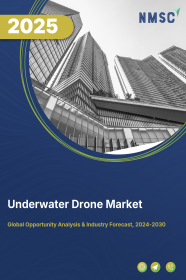
Underwater Drone Market by Type (Remotely Operated Vehicle (ROV), Autonomous Underwater Vehicles (AUV), and Hybrid Vehicles), by Product (Micro, Small and Medium, Light Work-Class, and Heavy Work-Class), by Propulsion System (Electric System, Mechanical System and Hybrid System), By Payload (Camera, Sensors, Inertial Navigation Systems, and Others), and Others - Global Opportunity Analysis and Industry Forecast 2023-2030
US Tariff Impact on Underwater Drone Market
Trump Tariffs Are Reshaping Global Business
Market Definition
The global Underwater Drone Market size was valued at USD 3.94 billion in 2022 and is predicted to reach USD 10.94 billion by 2030 with a CAGR of 13.6% from 2023-2030. Underwater drones, also known as submersible robotic systems, are technological marvels designed to explore and operate in aquatic environments. These remarkable devices can be operated either autonomously or remotely, employing advanced wireless communication technology or, if necessary, utilizing cables for enhanced control and data transmission.
The design of underwater drones is characterized by ruggedness and robustness, making them capable of withstanding the most challenging water conditions. These resilient machines have been specifically engineered to endure harsh underwater environments. Depending on the operational requirements and prevailing conditions, underwater drones have an impressive submersion capacity, often remaining submerged for extended periods, typically ranging from six to eight hours.
Equipped with an array of cutting-edge components, underwater drones go beyond their primary function of exploration. These versatile machines are outfitted with a diverse set of tools, including sophisticated sensors and robotic arms, enabling them to accomplish a wide range of underwater tasks with precision and efficiency. Their capabilities extend to vital operations such as search and rescue missions, facilitating the growth of fish farming ventures, and supporting groundbreaking studies in marine biology.
Market Dynamics and Trends
The increasing utilization of underwater drones in the offshore oil and gas industry for infrastructure inspection, maintenance, and repair is driving market growth. This is due to the numerous advantages offered by underwater drones, such as their high maneuverability in deep water, extended dive times, and their ability to safely explore areas that are hazardous for human divers.
The high demand for underwater drones in the marine industry is further fueling market growth, particularly for underwater survey missions. These missions involve detecting and mapping submerged wrecks, rocks, and obstructions that pose navigation hazards to both commercial and recreational vessels. Underwater drones prove highly valuable in such survey operations as they can be equipped with cameras, lights, and sonar systems.
Furthermore, the military and defense sector's increasing adoption of underwater drones for naval asset inspections, hydrography, intervention against waterborne improvised explosive devices (WIEDs), and port security is driving market growth.
However, the underwater drone market growth is restrained by the limited remote-control range of these drones. This limitation arises from the use of radio waves, which do not propagate effectively through water, and direct-beam optical communication systems that depend on line of sight and water turbidity for their range.
On the contrary, the introduction of artificial intelligence (AI) in underwater drones presents significant growth opportunities for the market in the coming years. AI enables drones to intelligently analyze data from their sensors and learn how to respond in highly dynamic deep-water environments. This advancement is expected to create ample opportunities for market expansion.
Market Segmentations and Scope of the Study
The underwater drone market report is segmented on the basis of type, product, propulsion system, payload, application and geography. On the basis of type, the market is divided into remotely operated vehicle (ROV), autonomous underwater vehicles (AUV) and hybrid vehicles. On the basis of product, the market is classified into micro, small and medium, light work-class and heavy work-class. On the basis of propulsion system, the market is categorized into electric system, mechanical system and hybrid system. On the basis of payload, the market is divided into camera, sensors, inertial navigation systems and others. Geographic breakdown and analysis of each of the aforesaid segments includes regions comprising of North America, Europe, Asia-Pacific, and RoW.
Geographical Analysis
North America holds the lion's share of underwater drone market during the forecast period. This is attributed to factors such as very high military and defense expenditure in this region that enables the military to adopt new technologies and advance equipment’s including underwater drones. For instance, in May 2022, US Navy Naval Sea Systems Command (NAVSEA) has unveiled its first-ever Extra Large Unmanned Undersea Vehicle (XLUUV) called Orca, which was developed by The Boeing Company. Orca is based on Boeing’s existing underwater drone Echo Voyager 9 and comes with a top speed of eight knots and a maximum range of 6,500 nautical miles.
Moreover, presence of key market players such as Lockheed Martin, Northrop Grumman Corp and The Boeing Company further boost the market growth in this region. These industry leaders bring their expertise, resources, and innovative solutions to the market, contributing to the overall advancement and development of underwater drone technologies. Their active participation enhances the market's competitive landscape and supports the region's market dominance during the forecast period.
On the other hand, Asia Pacific is expected to show a steady rise in the underwater drone market due to the rapidly increasing adoption of under drones in aquaculture sector in the region. Underwater drones are widely adopted in the region for aquaculture equipment and infrastructure monitoring, net repair, mort retrieval and cleaning as these drones are highly efficient and it can replace expensive human intervention.
Moreover, increasing use of underwater drones in nuclear decommissioning in countries such as China, Japan and India owing to high number of reactor construction activities in these countries is expected to further drive the market growth in this region. Underwater drones are used in the nuclear decommissioning to conduct visual and radiometric inspection surveys, sample collection, and demolition/size reduction of contaminated structures.
For instance, in March 2022, Japan has started decommissioning the Fukushima Daiichi Nuclear Power Station. The project consists of treating contaminated water; removing nuclear fuel debris, nuclear fuels and managing radiological waste that requires the use of underwater drones.
Competitive Landscape
The underwater drone industry comprises of various market players such as BAE Systems, Kongsberg, Lockheed Martin, Saab AB, Northrop Grumman Corp, Oceaneering International Inc., The Boeing Company, Atlas Elektronik, Boston Engineering Corporation and Fugro N.V. These market players are adopting several strategies such as partnerships and developing products across various regions to maintain their dominance in the global market.
For instance, BAE Systems announced that it is developing a highly-configurable extra-large autonomous underwater vehicle (XLAUV) called Herne, for the future underwater battlespace. It is designed for a wide range of missions, including maritime surveillance, reconnaissance, and mine-hunting.
Moreover, in January 2022, Fugro and the National Robotarium in Edinburgh have joined forces to pioneer groundbreaking solutions for subsea infrastructure. By leveraging their combined technical expertise, extensive network, project funding, and state-of-the-art facilities, Fugro aims to accelerate the development of revolutionary autonomous underwater solutions.
Key Benefits
-
The underwater drone market report provides the quantitative analysis of the current market and estimations through 2023-2030 that assists in identifying the prevailing market opportunities to capitalize on.
-
The study comprises a deep dive analysis of the underwater drone market including the current and future trends for depicting the prevalent investment pockets in the market.
-
The information related to key drivers, restraints and opportunities and their impact on the global market is provided in the report.
-
The competitive analysis of the market players along with their market share in the market.
-
The SWOT analysis and Porters Five Forces model is elaborated in the study.
-
Value chain analysis in the market study provides a clear picture of the stakeholders’ roles.
Underwater Drone Market Key Segments
By Type
-
Remotely Operated Vehicle (ROV)
-
Autonomous Underwater Vehicles (AUV)
-
Hybrid Vehicles
By Product
-
Micro
-
Small and Medium
-
Light Work-Class
-
Heavy Work-Class
By Propulsion System
-
Electric System
-
Mechanical System
-
Hybrid System
By Payload
-
Camera
-
Sensors
-
Inertial Navigation Systems
-
Others
By Application
-
Defense & Security
-
Scientific Research
-
Commercial Exploration
-
Others
By End-User Industry
-
Offshore Energy
-
Military & Defense
-
Aquaculture
-
Marine
-
Nuclear
By Region
-
North America
-
U.S
-
Canada
-
Mexico
-
-
Europe
-
UK
-
Germany
-
France
-
Italy
-
Spain
-
Denmark
-
Netherlands
-
Finland
-
Sweden
-
Norway
-
Russia
-
Rest of Europe
-
-
Asia-Pacific
-
China
-
Japan
-
India
-
South Korea
-
Australia
-
Indonesia
-
Singapore
-
Taiwan
-
Thailand
-
Rest of Asia-Pacific
-
-
RoW
-
Latin America
-
Middle East
-
Africa
-
KEY PLAYERS
-
BAE Systems
-
Kongsberg
-
Lockheed Martin
-
Saab AB
-
Fugro
-
Northrop Grumman Corp.
-
Oceaneering International Inc.
-
The Boeing Company
-
Atlas Elektronik
-
Boston Engineering Corporation

















 Speak to Our Analyst
Speak to Our Analyst





















